Priority Unga gold drill targets found
North of 60 Mining News – January 17, 2020
Last updated 9/26/2020 at 11:42am
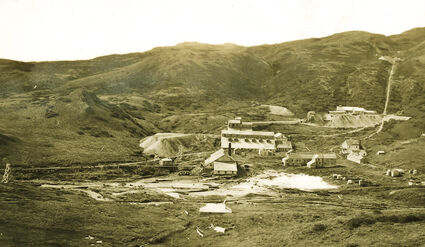
Alaska State Library – Historical Collections
Redstar's 2019 mapping at Unga identified two high-priority exploration targets in the immediate area of the historic Apollo and Sitka mines, considered to be the first high-grade gold mines in Alaska.
Redstar Gold Corp. Jan. 13 reported that recently completed structural mapping on its Unga gold project on the Alaska Peninsula has identified several new priority drill targets along the Shumagin and Apollo-Sitka trends.
The Unga project covers roughly 93 square miles (240 square kilometers) of two islands south of the Alaska Peninsula, Unga and Popof islands, that has long been known for its high-grade gold. The Apollo and adjacent Sitka mines, established on Unga Island in 1886, produced roughly 150,000 ounces of gold from high-grade epithermal veins before they were shuttered in 1922.
Much of Redstar's exploration in recent years has focused on two high-grade gold trends – Apollo-Sitka and Shumagin – that each cut roughly six miles across Unga Island. Apollo-Sitka hosts the historic Apollo Mine and Shumagin is a parallel high-grade gold trend about 2,000 meters to the northwest.
Carried out by Craig Pearman, formerly the chief geologist for Kinross Gold Corp. in West Africa, the recent structural mapping focused on five of 40 distinct high prospectivity areas within the Unga project outlined by previous drilling and surface sampling of mineralized outcrop. These targets include an extension of the SH-1 (formerly referred to as the Shumagin) zone; Bloomer Ridge and Aquila on the Shumagin trend; and brownfield targets at the Apollo and Sitka historic mine sites; as well as at Empire Ridge and Rising Sun prospects, which lie along the Apollo-Sitka trend.
Redstar said an interpretation of surface linear features at SH-1 shows that high grade gold bearing structures on the Shumagin Trend are situated tangentially (comes in contact but does not cross) to intrusives. The company says this is analogous to some gold deposits in the Refugio mining district in Chile, home to Kinross' past producing Maricunga gold mine. One of these linears indicates that the western extension of the SH-1 zone is a southwest striking splay that extends toward Pray's Vein. Surface samples taken by Redstar at Pray's Vein have returned up to 11.8 grams per metric ton gold, and a drill hole by Battle Mountain Gold in the late 1980s cut 2.4 meters grading 0.18 g/t gold and 6.9 g/t silver when the hole was abandoned at 45 meters. A mapped structure that covers a more than 1,000-meter-long area between SH-1 and Pray's Vein may be the southwestern extension of the SH-1 and is a high priority drill target.
Bloomer Ridge, which is located 800 meters south and parallel to SH-1 zone, was another area recently investigated by Redstar. Abundant millimetric scale, iron oxide bearing, quartz-carbonate veining with as much as 4.7 g/t gold was identified along 1,400 meters of strike at Bloomer Ridge. The company said the proximity and similarity in style of mineralization to SH-1 zone indicates the Bloomer Ridge gold may be from the same source. Also, Bloomer Ridge is topographically higher than SH-1, which could mean the underlying mineralization may be better preserved. Bloomer Ridge is a high priority mapping target for Redstar with the goal of eventual drilling at this high-priority target.
Redstar's mapping shows that historic mining at Apollo-Sitka was focused on dilational structures resulting from rotation of the strike direction within a shear duplex. This exercise revealed a new dilational structure in the immediate area of the historic Apollo mine. Furthermore, surface sampling returned assays as high as 104 g/t gold immediately above previously mapped mine workings where significant amounts of sulfide-hosted gold and base metal mineralization was abandoned at the turn of the 19th century because the metals were not recoverable with the stamp-mills used at that time. The underground workings, mapped and sampled by Alaska Apollo Mining in the 1990s, followed a vein for 500 meters of strike and returned underground assays up to six meters grading 8 g/t gold, along with silver, zinc and lead.
Redstar said the presence of an untested dilational structure near the historic Apollo-Sitka Mine, as well as high-grade samples at surface with historically recorded mineralization underneath has yielded two high probability drill targets.
The 2019 Unga mapping program also investigated Aquila, a Shumagin Trend target about 3.5 miles (5.7 kilometers) southwest of SH-1. Surface sampling by Battle Mountain in the 1980s returned assays up to 30 g/t gold at Aquila and one historical hole, DDH AQAME02, cut 0.46 meters averaging 103 g/t gold. Redstar's 2019 sampling at Aquila shows two zones within a shear duplex within 400 meters of a centrally located intrusive. Redstar said Aquila is a high probability target for further drilling.
"This structural mapping exercise has added significantly to understanding what controls mineralization at the Unga project and opens up several new, high probability drill targets adjacent-to and on-strike with known high-grade gold and base metal zones on the Shumagin and Apollo-Sitka trends, which will be pursued during the 2020 field season," said Redstar Gold President John Gray. "We are also working on a maiden NI 43-101 compliant resource on the Shumagin zone (now SH-1) to be completed in Q1 (first quarter) and provide a resource as a foundation upon which to build value for Redstar shareholders."
–SHANE LASLEY


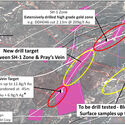
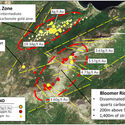

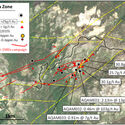
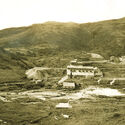
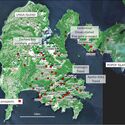












Reader Comments(0)